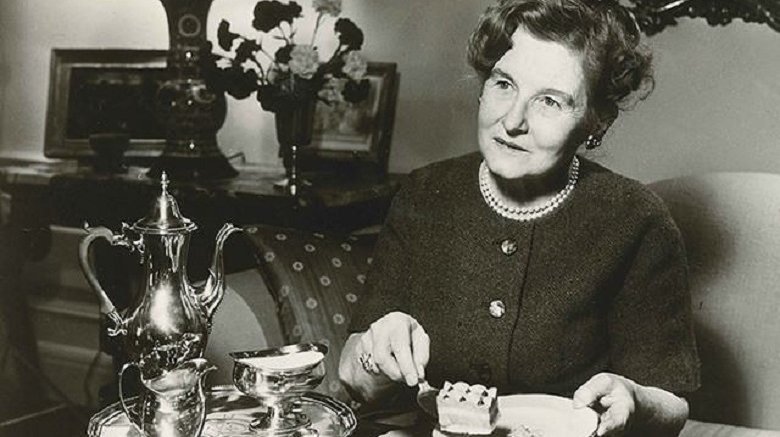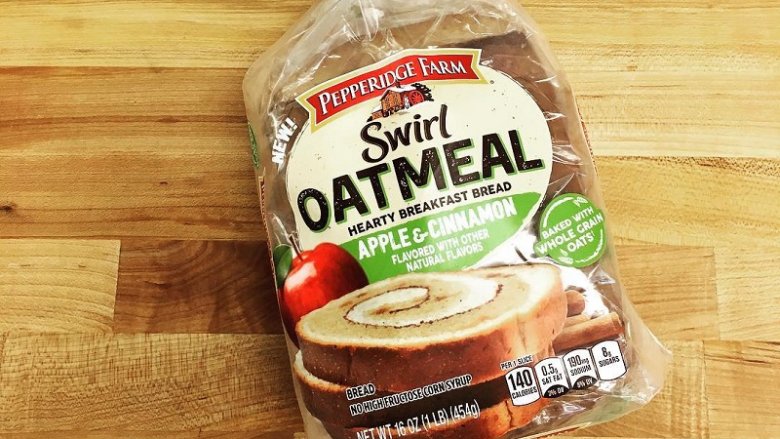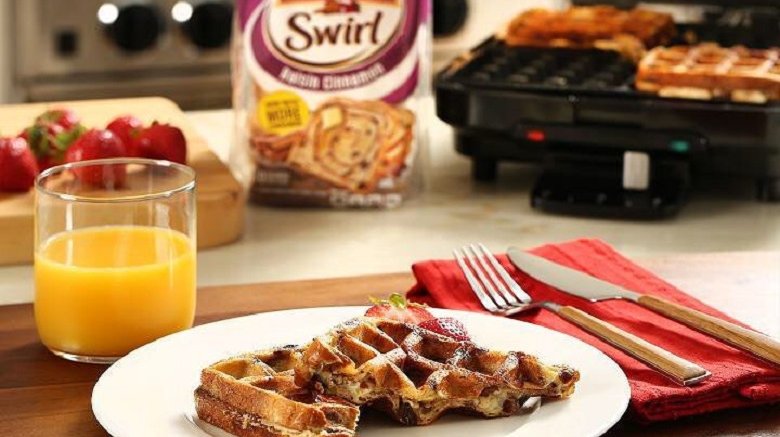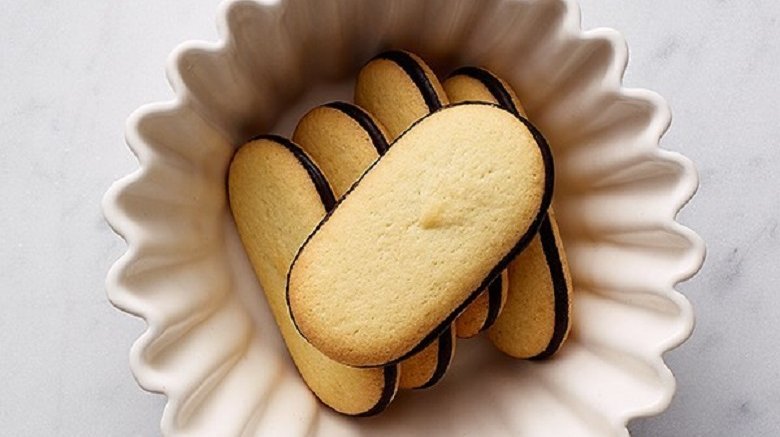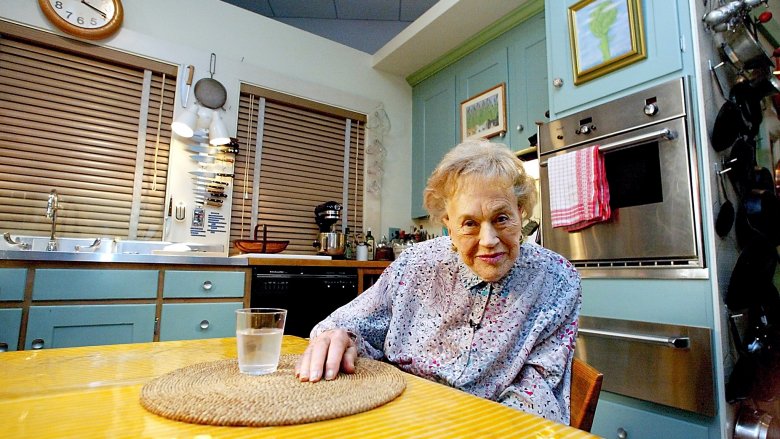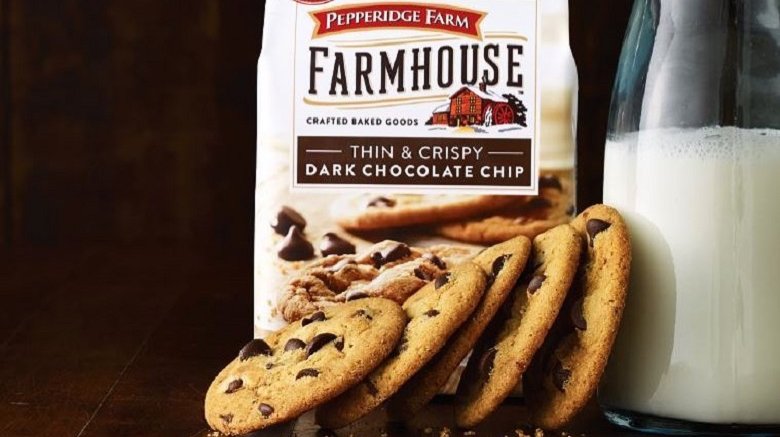The Untold Truth Of Pepperidge Farm
Everyone has their favorite Pepperidge Farm cookies (and the odds are on your side if you guess Milano). And then, of course, there's the Goldfish crackers, those delicious little snacks that have had a place in our lunchboxes and cupboards for decades. Pepperidge Farm is the stuff of special occasions, special moments, and treats like no other, but how much do you really know about the company that made their name on those delicate, elegant, European-style cookies?
Pepperidge Farm is a real place (but it's not on the logo)
Pepperidge Farm really does exist, and technically, there are two. The first one was the patch of land owned by company founder Margaret Fogarty Rudkin and her husband, Henry. In the 1920s, Henry enjoyed major success on Wall Street, and they were able to buy a farm in Fairfield, Connecticut; it's one most of us can only dream of. There was a Tudor-style mansion, a 12-horse stable, 125 acres, and even servants to help them maintain everything. According to the New England Historical Society, the estate got its name from some of the sorghum (or pepperidge) trees on the property.
That familiar Pepperidge Farm logo doesn't show any of the buildings on the Rudkin's estate, though. The mill on the logo is actually the Wayside Inn Grist Mill in Massachusetts, and it was built by Henry Ford. By 1952, it was employed by Pepperidge Farm, shipped out 48 tons of whole wheat flour each month, and became the image of the company. It's still open, still grinds flour, and you can visit it and Longfellow's Wayside Inn.
The company was founded because of allergies
The Rudkins married in 1923, but their bliss was short-lived — and the New England Historical Society says it ended not only with the 1929 stock market crash, but with a polo accident that left Henry unable to work for months. They sold most of their prized possessions, but kept Pepperidge Farm, and were also faced with feeding their three sons.
The youngest of those sons, Mark, suffered from severe asthma, and when doctors told them it was aggravated by food allergies, they also recommended making more food at home. According to the Connecticut Women's Hall of Fame, Rudkin took her grandmother's bread recipe and started baking. Gradually, Mark improved so much that the doctor who had seen him started asking the Rudkins for loaves of bread in the hopes it would help other patients. The bread got more and more popular, she started selling to local stores, and Pepperidge Farm was born.
Her first bread was a total failure
There were a lot of growing pains in the earliest days of the company, and the very first came so early that many people might have given up. The Connecticut Women's Hall of Fame quoted Rudkin as saying, "My first loaf of bread should have been sent to the Smithsonian Institution as a sample of Stone Age bread, for it was hard as a rock and about one inch high."
She didn't give up, though, finally finding the recipe that worked just right. Building the foundations of the company didn't happen overnight, and it took three years for her endeavor to expand and move into Norwalk. In 1947 she opened her first large-scale bakery, and six years later, they were baking and shipping 77,000 loaves a week.
They're now competitors of the company they got their cookie recipes from
Pepperidge Farm may have started with bread, but you probably know them best for two other things: Goldfish crackers and cookies. There's actually a pretty fascinating story behind where their cookies and recipes came from, and Slate heard it from retiring Pepperidge Farm president Pat Callaghan.
According to Callaghan, Margaret Rudkin herself set off on a tour of Europe to find some inspiration for the line of cookies she envisioned. One of the places she stopped was Brussels, and at the Delacre cookie factory she found exactly what she was looking for in their delicate, elegant cookies. Then, something shocking happened.
Rudkin convinced Delacre — who wasn't selling their cookies in the US at the time — to not only give her their recipes, but send some of their bakers to Pepperidge Farm to give them a crash course in how it's done. All those Pepperidge Farm favorites are Delacre inventions from Belgium, and now that they're selling in the US, too, they consider Pepperidge Farm one of their competitors. Now you know why Pepperidge Farm cookies have a distinctly European flair — they're completely European!
Goldfish were a Swiss invention
How about those Goldfish crackers? Surely, there's nothing more American than those, right?
Not quite. Goldfish crackers were another delicious creation lifted right out of Europe by Rudkin and Pepperidge Farm. According to The Daily Meal, Goldfish were invented in Switzerland by a man named Oscar J. Kambly. His company — Kambly — still sells the little fish-shaped crackers, and they're clearly labeled: Goldfish — the Original. In Swiss they're called Goldfischli, and their "original" flavor is the same cheesy, puffy cracker that's sold in the states. Rudkin introduced them to Pepperidge Farm in 1962, and they've been a shocking success. In 2012, Business Wire reported on Pepperidge Farm's 75th anniversary, they also revealed some staggering numbers. Along with 206 million loaves of bread and 558 million Milano cookies, they produce 142 billion Goldfish crackers every year. That's a ton of crackers!
Machines to make Goldfish came to Pepperidge Farm via a WWII soldier
Some stories sound just too strange to be real, and that's definitely the case with the very true story of World War II soldier Ralph Hauenstein. Lauded as a hero by Michigan State University, Hauenstein served on the European front during the war, had a hand in the plan that misled the Nazis during the D-Day invasion, and helped crack coded messages from Germany.
After the war, he knew he wanted to help those ravaged by the fighting rebuild, and when he returned to travel the countryside for inspiration, he came across a German baker who was using a hand-cranked press to shape dough into little fishes. He engineered the production of equipment that would do the same thing on a large scale, gave the technology to that little German baker, and sold it to Pepperidge Farm. His creation jump-started the popularity of (and practicality of making) Goldfish crackers and ultimately allowed those billions of little fishes to make it to the grocery store shelves.
Goldfish aren't all smiles, and it's a challenge to make them
Goldfish smiles were added in 1997, a change made 35 years after they were first introduced to the American public. According to the New York Daily News, those smiles weren't going to last — the original plan was to make them a limited run of only a month. We all know that changed, but what you might not know is that getting those goldfish smiles onto those little crackers was a major endeavor. There was the logistical problems of getting the smiles deep enough to be seen but not too deep, and a team of engineers and designers was hired to come up with the perfect way to do it.
There was other, even more surprising research done, too. Pepperidge Farm hired a "smile psychologist", because they wanted to convey the right kind of happiness with their grinning fish. A human smile is as much in the eyes as it is in the mouth, and since the fish couldn't have the same crinkled eyes and happy face humans do, they wanted to make 100 percent sure the smile was a happy smile, and "not sneers or leers".
Their bread and their Goldfish went to space
It's difficult to imagine life on the space station, and in the earliest days of the US space program — and still today — keeping astronauts healthy is of the utmost importance. In 1971, the Apollo 14 crew was getting ready to head up into the sky, in the wake of the disastrous Apollo 13 mission. They were under a microscope, and according to The Tuscaloosa News, they were going to be taking some Pepperidge Farm bread with them. The white and rye breads heading into space used the same recipe Pepperidge Farm made for the shelves, and they were also making a cheddar cheese bread just for NASA.
The bread — which would make sandwiches with the help of Oscar Mayer — wasn't quite what you'd get off the shelves. It was baked in special pans to keep it square, and slices were exactly a half inch thick.
Goldfish have made it into space, too. According to CT Post, they had a spot on 1988's Discovery shuttle mission.
Milanos were a response to a logistical problem
Sure, everyone has their own individual tastes when it comes to cookies, but no one can deny that Milanos are a huge favorite. These chocolate-filled sandwich cookies almost didn't happen, and according to Slate, the original version of the Milano was actually a cookie called the Naples. It was similar to the Milano we now know and love, but with only the bottom cookie and a chocolate layer. Once the cookies started shipping into the Southern states, the heat there meant melted chocolate and a cookie-related disaster. They added the other half of the cookie sandwich, called it a Milano, and created a classic at the same time they averted a disaster.
Julia Child loved Goldfish crackers, and served them at Thanksgiving
When Emily Contois wrote her Food Studies Blog entry on Julia Child for the Radcliffe Institute for Advanced Study at Harvard, she focused on some of the things she found most important about this culinary legend. Among them was the fact that Goldfish crackers were her favorite snack, and it turns out she loved them so much she included them as snacks and an appetizer for her favorite Thanksgiving dinners (via Mental Floss).
Mary Bergin, who worked with Child on her show Baking with Julia, wrote a touching tribute to her for what would have been her 100th birthday (via PBS). Part of that tribute was a memory of her bowls of Pepperidge Farm Goldfish crackers, which she not only kept in her house but that were so important to her they were served at memorials after her death. You can't get a more moving celebrity endorsement than that!
They went after Trader Joe's with a major lawsuit
In 2016, the Hartford Courant announced the settlement of a lawsuit filed by Pepperidge Farm against Trader Joe's. According to the 24-page lawsuit, Trader Joe's Crispy Cookies were a direct infringement on the Milano cookie, from the cookie's appearance, shape, and chocolate layer right down to its packaging. Pepperidge Farm claimed the Trader Joe's version of the cooke had been "designed to trade on the Milano cookie's goodwill and reputation", and even cited the fact that doing a Google search for Milano cookies brought up a number of results leading potential customers to Trader Joe's.
Pepperidge Farm was seeking damages equivalent to three times what they had actually lost, along with lawyer fees and a court order stopping the sale of Trader Joe's cookies. When they announced a settlement, the terms of the agreement weren't made public, but the media did note that whatever had been decided on, Pepperidge Farm withdrew the lawsuit.
They're making a major push to go green
Pepperidge Farm is now under the umbrella of Campbell's Soup, and as such, they're reimagining themselves for the 21st century. It's the behind-the-scenes things that have changed, and they're making a major push to be more environmentally friendly.
In 2012, Pepperidge Farm opened the doors to their new headquarters in Norwalk, Connecticut. The $30 million building was LEED-certified, used recycled material in its construction, and was state-of-the-art when it came to green technologies.
They extended that green technology to their bakeries, and in 2015 Pepperidge Farm's Bloomfield bakery became one of the few industrial bakeries in the country to have a solar array. It's the second largest for Campbell's companies, and according to their corporate press release, it's part of a strategy to reduce energy use by 35 percent for each ton of product they produce. That same year, they announced they were partnering with the Environmental Defense Fund to reduce greenhouse gas emissions and help improve water quality by reevaluating their use of fertilizer and soil conservation practices on the farms that produce their grains. They also announced they were removing high fructose corn syrup, developing organic versions of their favorite product — like Goldfish — and removing GMOs.


